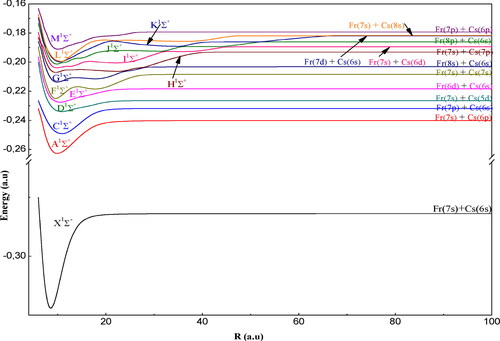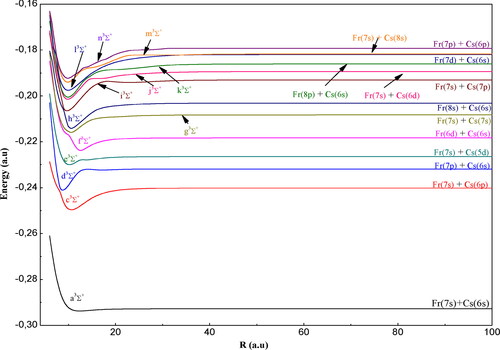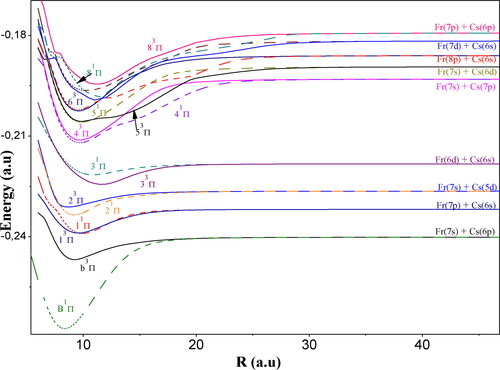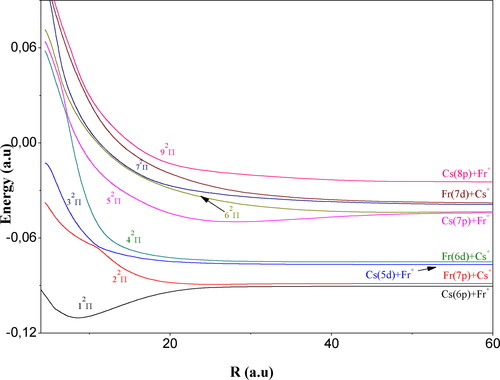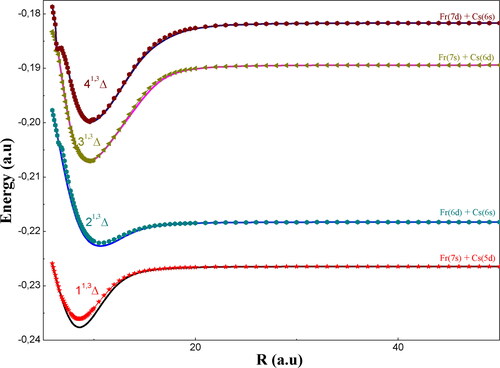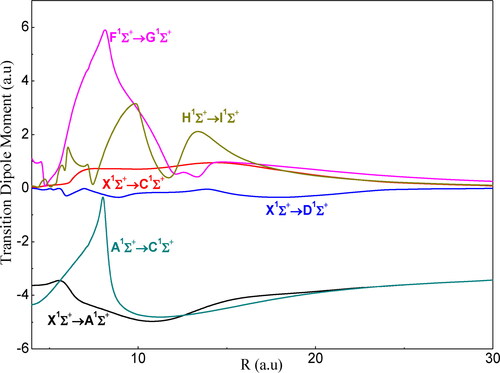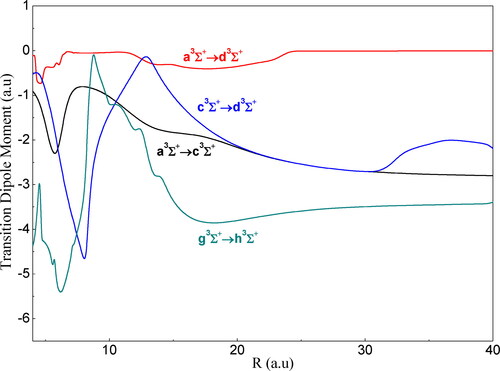 ?Mathematical formulae have been encoded as MathML and are displayed in this HTML version using MathJax in order to improve their display. Uncheck the box to turn MathJax off. This feature requires Javascript. Click on a formula to zoom.
?Mathematical formulae have been encoded as MathML and are displayed in this HTML version using MathJax in order to improve their display. Uncheck the box to turn MathJax off. This feature requires Javascript. Click on a formula to zoom.Abstract
In this study, the potential energy curves (PECs) and dipole moments for 1,3Σ+, 1,3Π and 1,3Δ states of the molecule FrCs and for 2Σ+, 2Π and 2Δ of (FrCs)+ have been computed using a quantum chemistry procedure. This method is based on pseudo-potentials for the representation of atomic core, effective core polarization potential, and large Gaussian basis sets. Besides, we have been deduced from these curves the vibrational levels and the spacing's for all symmetries. The (FrCs)+ and FrCs are modeled as one and two valence electrons, respectively and the Fr+ and Cs+ core are indicated by a pseudo-potential with middle relativistic effects together with the potential of effective core polarization. Since, no experimental results are available for these systems, we have compared our result with the theoretical result found by Aymar et al. and found a good agreement.
1. Introduction
The recent development (Sprouse, Fliller, Grossman, Orozco, & Pearson, Citation2002) of trapping of radioactive and laser cooling atoms opens ways for new investigations as the research for the β decay, electric dipole moment (EDM), Bose–Einstein condensation, cold atom–atom collisions and more precise atomic clocks.
Laser cooling was first discovered on trapped ions (Neuhauser, Hohenstatt, Toschek, & Dehmelt, Citation1978; Wineland, Drullinger, & Walls, Citation1978), which has related to the development of major fields of research. Example of such research is the improvement of spectroscopy and frequency standards (Wineland, Citation1984), tests of spatial anisotropy (Prestage, Bollinger, Itano, & Wineland, Citation1985), millikelvin ionic temperatures (Bergquist, Itano, & Wineland, Citation1987; Nagourney, Janik, & Dehmelt, Citation1983); confinement of atoms to less than an optical wave length (Bergquist, Hulet, Itano, & Wineland, Citation1986; Bergquist et al., Citation1987; Janik, Nagourney, & Dehmelt, Citation1985; Nagourney, Sandberg, & Dehmelt, Citation1986; Sauter, Neuhauser, Blatt, & Toschek, Citation1986) examination of quantum jumps on single ions (Nagourney et al., Citation1986) and Doppler-free, recoilless spectroscopy (Bergquist et al., Citation1987; Nagourney et al., Citation1986). The laser cooling of ions is considerably enabled as their charge allows the ions to be trapped in deep wells. This permits long interaction times and the movement of numerous photon momentum. Moreover, the alkali metals have lately attracted increased attention both experimentally and theoretically because of their importance in the creation of cold molecules (Aymar, Dulieu, & Spiegelman, Citation2006; Comparat, Drag, Fioretti, Dulieu, & Pillet, Citation1999; Drag et al., Citation2000; Dulieu, Raoult, & Tiemann, Citation2006; Koch, Luc-Koenig, & Masnou-Sweeuws, Citation2008; Vanhaecke et al., Citation2004). The component francium has an atomic number Z = 87 and does not have a stable isotope. Francium has a life time of 21.8 min.
The object of this study is to determine the dipolar, vibrational and electronic properties of the FrCs and (FrCs)+ systems including: (i) the potential energy curves of various states and the spectroscopic properties (Re: the equilibrium distance, De: well depth, Te: the transition energies, Be: rotational constant, ωe vibrational constant and ωeχe Anharmonic constant). (ii) The permanent dipole moment (PDM) and transition dipole moment (TDM) functions. (iii) The vibrational properties.
Aymar et al. (Citation2006) have been calculated in 2006 the electronic structure of FrCs molecule and its cation. Their investigation has been realized via configuration interaction (CI) approach based on the effective core potential, as the core–valence impact.
This study has been defined as follows: In Section 2, we illustrate the theoretical approach based on adiabatic ab initio investigation. In Section 3, we give the adiabatic potential energy curves (PECs), their vibrational level and their spectroscopic properties. In Section 3, we present our results of the transition and permanent dipole moments. Finally, Section 4 contains the conclusions.
2. Computational approach
2.1. Basis set
We have taken core polarizability of the francium atom from Aymar et al. (Citation2006), which is αFr =20.38 Then, ρs=3.1629 Bohr, ρp=3.027 Bohr and ρd=3.1068 Bohr are the optimized cutoff parameters. Whereas, to have an excellent representation of the atomic levels (7s; 7p; 6d; 8s; 8p; 7d; 9s and 9p), we have optimized a large Gaussian-type orbital (GTO) basis set which is 8s/6p/5d for the Fr atom. While for the cesium atom, we used this basis set (8s/6p/7d). Our choice of the basis set improves the calculated atomic level energies of the francium and cesium compared with previous studies, for example the work of Aymar et al. (Citation2006).
In , we show our theoretical ionization energies of Fr and those for Aymar et al. (Citation2006) which has been compared with the available experimental one (Ralchenko, Kramida, & Reader J NIST ASD Team, Citation2011). The examination of our theoretical and the experimental data indicates an excellent agreement between them (Ralchenko et al., 2011), and we observe that the biggest difference is 88 cm−1. In addition, in , we have been compared our molecular states beneath this ionic limit (Fr++Cs–) with the experimental ones for the molecule FrCs and the molecular ion (FrCs)+, respectively. The differences are acceptably small and it is in great accordance with the experimental data (Ralchenko et al., 2011). Clearly, in , the corresponding errors between the theoretical and experimental energies do not exceed 88 cm−1.
Table 1. Theoretical ionization energies (in cm−1) of francium atom compared with the experimental energies (Ralchenko et al., 2011).
Table 2. Spectroscopic constants for 1,3Σ+, 1,3Π and 1,3Δ states of FrCs.
The present calculations display the ab initio approach proposed by Barthelat and Durand (Citation1978) and Durand and Barthelat (Citation1975) based on a nonempirical pseudo-potentials method to restrict the number of electrons to just two. Actually, our molecule is composed of 87 electrons for Fr and 55 electrons for Cs. The (FrCs)+ and FrCs are considered as an effective one and two valence electron, respectively. In our computation, the theoretical energies were determined at self-consistent field (SCF) level based on the core polarization potentials operator (CPP) method. Then, the full CI was calculated using the package code, which is developed by the LCPQ in Toulouse (CIPSI, MOYEN, BDAV) (Barthelat & Durand, Citation1978; Berriche & Gadea, Citation1995; Boutalib & Gadea, Citation1992; Boutalib, Daudey, & Mouhtadi, Citation1992; Chaieb, Habli, Mejrissi, Oujia, & Gadea, Citation2014; Dardouri, Habli, Oujia, & Gadéa, Citation2012; Duplaa & Spiegelmann, Citation1996; Durand & Barthelat, Citation1975; Evangelisti, Daudey, & Malrieu, Citation1983; Foucrault, Millie, & Daudey, Citation1992; Gadea & Pelissier, Citation1990; Groß & Spiegelmann, Citation1998; Habli, Dardouri, Oujia, & Gadéa, Citation2011; Habli et al., Citation2015, Citation2016; Hamdi et al., Citation2018; Huron, Malrieu, & Rancurel, Citation1973; Khémiri, Dardouri, Oujia, & Gadea, Citation2013; Khelifi, Oujia, & Gadea, Citation2007; Mtiri et al., Citation2017; Pélissier, Komiha, & Daudey, Citation1988; Poteau & Spiegelmann, Citation1995; Souissi et al., Citation2017a, Citation2017b). For the model of the interaction between the valence electrons with the polarizable Fr+ and Cs+ cores, the core polarization potential VCPP giving by Müller, Flesch, and Meyer (Citation1984) is given by
(1)
(1)
In this formula, is the electrostatic field that is at center γ generated through the valence electrons and all the other centers’ cores and
is the dipole polarizability of the core γ, which is written as
(2)
(2)
and
are the vectors of the core–electron and that for core–core, respectively. We have taken the l-dependent cut off form developed by Foucrault et al. (Citation1992) the operator of the cut off
is written as:
(3)
(3)
The formulation below presents the cutoff radius
(4)
(4)
Whereas, the operator is the spherical harmonic in the center of the core γ.
Besides, to activate the spectroscopic works at the theoretical and experimental levels, then, to offer a sight for the feature of FrCs, the vibrational levels were fitted by the method of least-squares specified as follows
(5)
(5)
3. Results and discussions
3.1. Adiabatic PECs and spectroscopic properties of FrCs and (FrCs)+ systems
The potential energy curves provide a structure for the assessment of the collision determinations of the inelastic and elastic phenomena. Furthermore, new spectroscopic results give details concerning the binding of systems. These spectroscopic constants have been calculated by using the technique of interpolation of the potential energies while, ωe and ωeχe have been investigated from a fit of a vibrational levels’ energies. In this work, the PECs have been determined for a large spectrum of internuclear distances between the Cs+ ion and the Fr atom from 5 to 100 a.u. Moreover, the PECs are shown in , respectively, for the 1Ʃ+, 3Ʃ+ and 2Ʃ+. The investigated spectroscopic parameters have been compared with the obtainable data and registered in , respectively, for FrCs and (FrCs)+ systems.
Table 3. Spectroscopic constants for 2Σ+, 2Π and 2Δ states of (FrCs)+.
Table 4. Avoided crossing positions.
Our dissociation energy for the ground state (FrCs) and (FrCs)+ (De=3517.97 cm−1 and De = 5048 cm−1) are in excellent accordance with the obtainable data found in the study of Aymar et al. (Citation2006) (De =3553 cm−1, De = 5054 cm−1). For the excited states A1Σ+, C1Σ+, D1Σ+ and E1Σ+ of FrCs, we observe in curves with regular forms and have just one potential well located at equilibrium distances Re equal to (9.98 a.u, 10.81 a.u, 11.26 a.u and 10.90 a.u), respectively. Moreover, the profound of these wells were differ from 1700 to 5000 cm−1 (see ). Besides, for the other excited states of FrCs, we can see curves with double and triple potential wells. Take an example, the F1Σ+ state has two minimums where the first one (Re =9.55 a.u. and De =3651.33 cm−1) is deeper than the second one (Re =18.67 a.u and De=2073.48 cm−1). We can observe an important avoided crossing with the I1Σ+ state observed at the distance RAC=32 a.u, where the feeble energy difference between the two states is 20 cm−1. Therefore, this minimal difference gives us adiabatic transitions. Moving on to the highest states, we observe many potential wells and the avoided crossings were specified. Then, for the molecular ion (FrCs)+, their curves in have single and double wells. For example, we can explain the state of D2Σ+, which has two wells, the first at 11 a.u. and the second at 29.5 a.u (see ), depending on the avoided crossing with the adjacent E2Σ+ state at RAC =16.1 a.u, where the small difference of energy in this position is relative to 136 cm−1.
We have been displayed the curves of symmetry 3Σ+ of the molecule FrCs in . We note that the first state a3Σ+ is almost an attractive state, where De =311.77 cm−1 and Re =12.43 a.u., which is in good accordance with the results found in the work of Aymar et al. (Citation2006), De =217.9 cm−1, Re =12.33 a.u. (see ). Going to higher states, their shapes are involved with various potential wells: There is double, triple as well as multiple. We observed at short distances a set of avoided crossings between the examined states, which is leading to abnormal oscillation comportment in their potential energy curves. We have been displayed in the difference of the energy between the states at the avoided crossings' positions PAC.
Turning now to the symmetries 1,3Π and 2Π of the two systems FrCs and (FrCs)+, we observe that various states are repulsive in like the 2 1,3Π and 3 2Π states. The adiabatic 1,3Π curves of the molecule FrCs have nearly degenerated as exposed in . Therefore, we can observe several avoided crossings, which a few of them are corresponding to underlying of the charge transfer states and the others are related to the interaction between attractive and repulsive curves. The whole states of Π symmetry singlet and triplet attained their asymptotic limits rapidly at Re =40 a.u.
For the symmetries 1,3Δ and 2Δ of FrCs and (FrCs)+, we can see in that all the curves are repulsive. In , we have been presented their spectroscopic parameters, respectively. We notice that these electronic states quite quickly achieve their asymptotic limits (exactly at Re at about 30 a.u. for the two systems) and the 1,3Δ curves with the identical dissociation limit are nearly degenerate. To recapitulate, the spectroscopic parameters for the triplet and singlet states achieved the uniform limits are nearly equal.
3.2. Vibrational levels of the molecule FrCs
The vibrational levels were investigated for the whole symmetries of FrCs. We start by the , which is presented the PECs of the (X and F) 1Σ+ with the vibrational levels spacing (Gv–Gv–1) related to the vibrational number of the levels “V”. For the ground state X1Σ+, we observe a deep well that is contains 170 vibrational levels, which show a linear comportment considering an anharmonic shape as Morse in their potential energy curves. In addition, the spacing becomes tiny and vanish at this asymptotic limit (Fr(7s)+Cs(6s)). Similarly, we observe an identical form for the states, which have only one well depth. Moving on to the spacing for F1Σ+, the behaviors present a shape that is linear up to v = 71 corresponding to an anharmonic potential at Re =9.55 a.u. Then, we can see an abrupt variation, which indicates an appearance of the second depth at (18.67 a.u.), which is less deep than the other one. In , we have been plotted the vibrational level spacing of (G–M) 1Σ+. We note that for the highest states, their vibrational level spacing decreases in a linear behavior then an abrupt variation corresponded to the little enlargement of the first well. Therefore, these levels come to be greatly narrowed and we detect that quasi-degeneracy, which explain the appearance of the larger second well in the PECs.
Figure 8. Vibrational spacing (left) and potential energy curves (right) for (X and F) 1Σ+ states of FrCs.

Moving on to the vibrational levels spacing for 3Σ+ states, we can see for (a–e) 3Σ+ a linear shape related to the simple depth in their PECs (see Supplementary Materials, ). The higher states as k and m 3Σ+ states show an abrupt change in their spacings, which indicates an appearance of the second well (see Supplementary Materials, ).
3.3. Permanent and transition dipole moment of FrCs
In , we have been reported the adiabatic PDM and TDM from all symmetries 1,3Σ+. We start with , where we can see the PDM functions of 1Σ+ states differ leisurely at the short and large internuclear distances; they show an abrupt variation (see ). Every state one after one; conduct to a maximum then drops to zero. Moreover, these adiabatic curves create a linear form with the fragments of the (–R) function as of the ionic state (Fr++Cs–) and move via creation knot between consecutive pieces when are combined. In addition, we note that the avoided crossings are very feeble because of the acuity of the slopes surrounding the crux of the dipole. The avoided crossings in the PECs and the crossings in the permanent dipole moment curves were caused by the production of the ionic curve. As consequences of these crossings that they are produced by the charge transfer or excitation efficacy. Such as, the neutralization cross-sections fundamentally depended on the crossing chains, thus, many astrophysical conditions (Barklem, Belyaev, Dickinson, & Gadea, Citation2010; Belyaev, Barklem, Dickinson, & Gadea, Citation2010; Croft, Dickinson, & Gadéa, Citation1999; Dickinson, Poteau, & Gadea, Citation1999) are their significant field for charge transfers. Indeed, the permanent dipole moment curves yields a direct figure of the ionic nature in 1Σ+ of the electronic wave function.
Figure 10. (a) Permanent dipole moment for the 1Σ+ states for the FrCs and (b) zoom for the PDM at short distance.
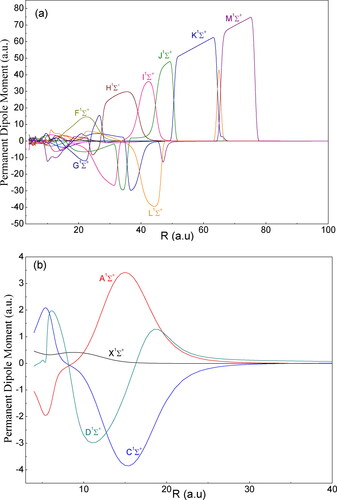
Figure 11. (a) Permanent dipole moment for the 3Σ+ states for the FrCs and (b) zoom for the PDM at short distance.
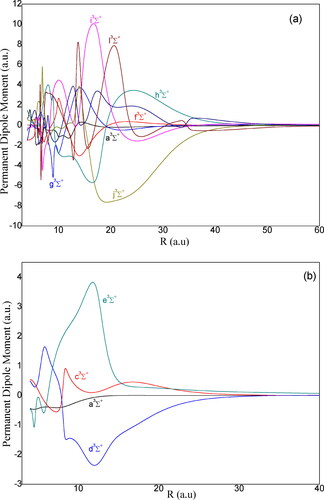
The PDM curves for 3Σ+, 1,3Π and 1,3Δ are displayed in and S3–S4. We can see in the PDM curves for 3Σ+ symmetry where the specified variations are presented at short distances before35 a.u. Furthermore, the PDM curves are very important for they have a significant influence on other excited states. In addition, they increase and disappear at large internuclear distances. For example, j3Σ+ and h3Σ+ states show a maximum (μmax = −7.49 a.u. and −5.74 a.u.) respectively, at the distances Re =21 a.u and 16.5 a.u., respectively. After that, it leisurely decreases. Moreover, the last maximums are related to the avoided crossings in their PECS. The permanent dipole moment figures of the symmetry 1,3Π present a significant variation at short distances then drop quickly to zero (see Supplementary Materials, ). In the Supplementary Materials , we can see that the permanent dipole moment functions of 1Δ are uniform to the 3Δ ones that clarify the degeneracy in their potential energies curves.
To complete this work, it is important to illustrate the curves of the transition dipole moment in the adiabatic representation. In , we have been presented the curves of 1Σ+ and 3Σ+, which have been determined for the first time. In , we can see the presence of several peaks, which are related to the avoided crossings in the potential energies curves at certain distances. For example, the F–G transition dipole moment that indicates a peak at about 8.1a.u. is related to the avoided crossing between the states F and G. Therefore, the high peak is observed for the H–I transition dipole moment figures, which are related to the crossing of the H–I the potential energies curves at the distance 13.5 a.u. To explain more, the avoided crossing was compared to the example of A–C when the peak is higher and less large. We have been displayed in the TDM figures for symmetry 3Σ+. Interestingly, the transition dipole moment figures have not a peak that is corresponding to the repulsive form in their potential energies curves and the absence of the avoided crossing. Further, the (c–d) 3Σ+ show a peak at Re= 8.1 a.u., which is related to the PAC between c and d states in their PECs.
To sum up, the related avoided crossings in the PECs are observed around the wide internuclear distances and the corresponding maximum data in the transition dipole moment curves. The significant transitions which are between the adjacent states (i, i + 1), as, the transitions between (J–K) 1Σ+ and (L–M) 1Σ+ states are more significant than the others.
4. Conclusion
In this theoretical study, we have been determined the electronic structure of the two systems FrCs and (FrCs)+ in several symmetries 1–3Σ+, 1–3Π and 1–3Δ. We have been studied the potential curves and their spectroscopic parameters by using the full configuration interaction (FCI) method. Comparing our results and the available results in the literature, we can see a good agreement between them. Furthermore, we have been determined the vibrational properties for the molecule FrCs by using a least-squares approach. Then, the PDM and TDM for the FrCs molecule have been determined for all symmetries.
Moreover, our new results of the permanent dipole moment functions present the presence of (–R) curve for the ionic limit (Fr++Cs–). In addition, the results show the several crossings in the potential energies curves data form the abnormal behaviors with numerous depths, which are corresponding to a linear shape in the PECs and the peaks in the transition dipole moment figures. To explain more, the potential energies curves create fragment by fragment for the (–R) function as a linear shape of the ionic state (Fr2+Cs–) and move on creating a crux between consecutive pieces when combined. These crossings are a consequence of the radiative the photo-association or charge exchange and spontaneous emission (Croft et al., Citation1999; Dickinson et al., Citation1999). These new data are very significant and helpful for further experimental and theoretical researches, as in spectroscopy (Malta et al., Citation1997) or collision fields (Barklem and O'Mara 2002; Hudson, Gilfoy, Kotochigova, Sage, & De Mille, Citation2008; Hummon et al., Citation2011; Staanum, Kraft, Lange, Wester, & Weidemüller, Citation2006; Zahzam, Vogt, Mudrich, Comparat, & Pillet, Citation2006).
Disclosure statement
These new results are very important and helpful for further theoretical and experimental researches, for example in spectroscopy or collision fields.
Additional information
Funding
References
- Aymar, M., Dulieu, O., & Spiegelman, F. (2006). Electronic properties of francium diatomic compounds and prospects for cold molecule formation. Journal of Physics B: Atomic, Molecular & Optical Physics, 39(19), S905–S927. doi:10.1088/0953-4075/39/19/S07
- Barklem, P.S., Belyaev, A.K., Dickinson, A.S., & Gadea, F.X. (2010). Inelastic Na + H collision data for non-LTE applications in stellar atmospheres. Astronomy & Astrophysics, 519, A20. doi:10.1051/0004-6361/201015152
- Barklem, P. S., & O'Mara, B. J. (2000). Broadening of lines of Be II, Sr II and Ba II by collisions with hydrogen atoms and the solar abundance of strontium. Monthly Notices of the Royal Astronomical Society, 311(3), 535–540. doi:10.1046/j.1365-8711.2000.03090.x
- Barthelat, J. C., & Durand, P. (1978). Non-empirical pseudo-potentials for molecular calculations. Gazzetta Chimica Italiana, 108, 1341–1357.
- Belyaev, A.K., Barklem, P.S., Dickinson, A.S., & Gadea, F.X. (2010). Cross sections for low-energy inelastic H + Na collisions. Physical Review A, 81(3), 032706. doi:10.1103/PhysRevA.81.032706
- Bergquist, J. C., Hulet, R. G., Itano, W. M., & Wineland, D. J. (1986) Physical Review Letters, 1699.
- Bergquist, J., Itano, W., & Wineland, D. (1987). Recoilless optical absorption and Doppler sidebands of a single trapped ion. Physical Review: Part A General Physics, 36(1), 428–430. doi:10.1103/physreva.36.428
- Berriche, H., & Gadea, F.X. (1995). Ab initio adiabatic and diabatic permanent dipoles for the low-lying states of the LiH molecule. A direct illustration of the ionic character. Chemical Physics Letters, 247(1–2), 85–88. doi:10.1016/0009-2614(95)01201-2
- Boutalib, A., Daudey, J.P., & Mouhtadi, M. E. (1992). Theoretical study of the lowest electronic states of CaH and CaH + molecules. Chemical Physics, 167(1–2), 111–120. doi:10.1016/0301-0104(92)80026-R
- Boutalib, A., & Gadea, F.X. (1992). Ab initio adiabatic and diabatic potential‐energy curves of the LiH molecule. Journal of Chemical Physics., 97(2), 1144–1156. doi:10.1063/1.463242
- Chaieb, M., Habli, H., Mejrissi, L., Oujia, B., & Gadea, F. X. (2014). Ab initio spectroscopic study for the NaRb molecule in ground and excited states. International Journal of Quantum Chemistry, 114(11), 731–747. doi:10.1002/qua.24664
- Comparat, D., Drag, C., Fioretti, A., Dulieu, O., & Pillet, P. (1999). Photoassociative spectroscopy and formation of cold molecules in cold cesium vapor: Trap–loss spectrum versus ion spectrum. Journal of Molecular Spectroscopy, 195(2), 229–235. doi:10.1006/jmsp.1999.7764
- Croft, H., Dickinson, A.S., & Gadéa, F.-X. (1999). A theoretical study of mutual neutralization in Li + H collisions. Journal of Physics B: Atomic, Molecular & Optical Physics, 32(1), 81–94. doi:10.1088/0953-4075/32/1/008
- Dardouri, R., Habli, H., Oujia, B., & Gadéa, F. X. (2012). Theoretical study of the electronic structure of KLi molecule: Adiabatic and diabatic potential energy curves and dipole moments. Chemical Physics, 399, 65–79. doi:10.1016/j.chemphys.2011.07.010
- Dardouri, R., Habli, H., Oujia, B., & Gadéa, F.X. (2013). Ab initio diabatic energies and dipole moments of the electronic states of RbLi molecule. Journal of Computational Chemistry, 34(24), 2091–2099. doi:10.1002/jcc.23363
- Dickinson, A.S., Poteau, R., & Gadea, F.X. (1999). An ab initio study of mutual neutralization in Na++ H–collisions. Journal of Physics B: Atomic, Molecular & Optical Physics, 32(23), 5451–5461). doi:10.1088/0953-4075/32/23/303
- Drag, C., Tolra, B. L., Dulieu, O., Comparat, D., Vatasescu, M., Boussen, S., … Pillet, P. (2000). Experimental versus theoretical rates for photoassociation and for formation of ultracold molecules. IEEE Journal of Quantum Electronics, 36(12), 1378–1388. doi:10.1109/3.892556
- Dulieu, O., Raoult, M., & Tiemann, E. (2006). Journal of Physical: Part B: Atomic Molecular Optimum Physics, 39, 1.
- Duplaa, P., & Spiegelmann, F. (1996). A pseudopotential hole‐particle treatment of neutral rare gas excimer systems. I. Formalism. Journal of Chemical Physics, 105(4), 1492–1499. doi:10.1063/1.472011
- Durand, P., & Barthelat, J.C. (1975). A theoretical method to determine atomic pseudopotentials for electronic structure calculations of molecules and solids. Theoretica Chimica Acta, 38(4), 283–302. doi:10.1007/BF00963468
- Evangelisti, S., Daudey, J.P., & Malrieu, J.P. (1983). Convergence of an improved CIPSI algorithm. Chemical Physics, 75(1), 91–102. doi:10.1016/0301-0104(83)85011-3
- Foucrault, M., Millie, P., & Daudey, J. P. (1992). Nonperturbative method for core–valence correlation in pseudopotential calculations: Application to the Rb 2 and Cs 2 molecules. Journal of Chemical Physics, 96(2), 1257–1264. doi:10.1063/1.462162
- Gadea, F.X., & Pelissier, M. (1990). Approximately diabatic states: A relation between effective Hamiltonian techniques and explicit cancellation of the derivative coupling. Journal of Chemical Physics, 93, 545.
- Groß, M., & Spiegelmann, F. (1998). A pseudopotential study of molecular spectroscopy in rare gas matrices: Absorption of NO in argon. European Physical Journal D: Atomic, Molecular, Optical & Plasma Physics, 4(2), 219–224. doi:10.1007/s100530050202
- Habli, H., Dardouri, R., Oujia, B., & Gadéa, F.X. (2011). Ab initio adiabatic and diabatic energies and dipole moments of the CaH + molecular ion. The Journal of Physical Chemistry A, 115(48), 14045–14053. doi:10.1021/jp204058y
- Habli, H., Mejrissi, L., Ghalla, H., Yaghmour, S. J., Oujia, B., & Gadéa, F. X. (2016). Ab initio investigation of the electronic and vibrational properties for the (CaLi) + ionic molecule. Molecular Physics, 114(10), 1568–1582. doi:10.1080/00268976.2016.1140843
- Habli, H., Mejrissi, L., Issaoui, N., Yaghmour, S. J., Oujia, B., & Gadea, F. X. (2015). Ab initio calculation of the electronic structure of the strontium hydride ion (SrH+). International Journal of Quantum Chemistry, 115(3), 172–186. doi:10.1002/qua.24813
- Hamdi, R., Abdessalem, K., Dardouri, R., Al-Ghamdi, A. A., Oujia, B., & Gadéa, F. X. (2018). Spectroscopic and electric dipole properties of Sr + Ar and SrAr systems including high excited states. Journal of Physics B: Atomic, Molecular & Optical Physics, 51(2), 025004. doi:10.1088/1361-6455/aa977d
- Hudson, E. R., Gilfoy, N. B., Kotochigova, S., Sage, J. M., & De Mille, D. (2008). Inelastic collisions of ultracold heteronuclear molecules in an optical trap. Physical Review Letters, 100(20), 203201. doi:10.1103/PhysRevLett.100.203201
- Hummon, M. T., Tscherbul, T. V., Kłos, J., Lu, H.-I., Tsikata, E., Campbell, W. C., … Doyle, J. M. (2011). Cold N + NH collisions in a magnetic trap. Physical Review Letters, 106(5), 053201. doi:10.1103/PhysRevLett.106.053201
- Huron, B., Malrieu, J.P., & Rancurel, P. (1973). Iterative perturbation calculations of ground and excited state energies from multiconfigurational zeroth‐order wavefunctions. Journal of Chemical Physics, 58(12), 5745–5759. doi:10.1063/1.1679199
- Janik, G., Nagourney, W., & Dehmelt, H. (1985). Doppler-free optical spectroscopy on the Ba^+ mono-ion oscillator. Journal of the Optical Society of America B, 2(8), 1251. doi:10.1364/JOSAB.2.001251
- Khelifi, N., Oujia, B., & Gadea, F.X. (2007). Dynamic couplings, radiative and nonradiative lifetimes of the A1Σ+ and C1Σ+ states of the KH molecule. Journal of Physical and Chemical Reference Data, 36(1), 191–202. doi:10.1063/1.2432887
- Khémiri, N., Dardouri, R., Oujia, B., & Gadea, F. X. (2013). Ab initio investigation of electronic properties of the magnesium hydride molecular ion. The Journal of Physical Chemistry A, 117(36), 8915–8924. doi:10.1021/jp403160q
- Koch, C., Luc-Koenig, E., & Masnou-Sweeuws, F. (2008). Accurate local density functional calculations with relativistic two-spinor minimax and finite element method for the alkali dimers. Physical Review A, 73, 033408.
- Malta, O. L., Brito, H. F., Menezes, J. F. S., Silva, F. R. G e., Alves, S., Farias, F. S., & de Andrade, A. V. M. (1997). Spectroscopic properties of a new light-converting device Eu(thenoyltrifluoroacetonate)3 2(dibenzyl sulfoxide). A theoretical analysis based on structural data obtained from a sparkle model. Journal of Luminescence, 75(3), 255–268. doi:10.1016/S0022-2313(97)00107-5
- Mtiri, S., Mejrissi, L., Habli, H., Al-Ghamdi, A.A., Oujia, B., & Gadéa, F.X. (2017). Theoretical investigation of the diatomic Van der Waals systems Ca + He and CaHe. Computational & Theoretical Chemistry, 1114, 33–46. doi:10.1016/j.comptc.2017.05.025
- Müller, W., Flesch, J., & Meyer, W. (1984). Treatment of intershell correlation effects in abinitio calculations by use of core polarization potentials. Method and application to alkali and alkaline earth atoms. Journal of Chemical Physics, 80(7), 3297–3310. doi:10.1063/1.447083
- Nagourney, W., Janik, G., & Dehmelt, H. (1983). Linewidth of single laser-cooled Mg ion in radiofrequency trap. Proceedings of the National Academy of Sciences of the United States of America, 80(2), 643–646. doi:10.1073/pnas.80.2.643
- Nagourney, W., Sandberg, J., Dehmelt, H. (1986). Shelved optical electron amplifier: Observation of quantum jumps. Physical Review Letters, 56(26), 2797–2799 doi:10.1103/PhysRevLett.56.2797
- Neuhauser, W., Hohenstatt, M., Toschek, P., & Dehmelt, H. (1978). Physical Review Letters, 41, 233.
- Pélissier, M., Komiha, N., & Daudey, J.P. (1988). One-center expansion for pseudopotential matrix elements. Journal of Computational Chemistry, 9(4), 298–302. doi:10.1002/jcc.540090404
- Poteau, R., & Spiegelmann, F. (1995). Calculation of the electronic spectrum of Li2 using effective core pseudopotentials and l-dependent core polarization potentials. Journal of Molecular Spectroscopy, 171(2), 299–308. doi:10.1006/jmsp.1995.1120
- Prestage, J. D., Bollinger, J. J., Itano, W. M., & Wineland, D. J. (1985). Limits for spatial anisotropy by use of nuclear-spin-polarized 9Be + ions. Physical Review Letters, 54(22), 2387–2390. doi:10.1103/PhysRevLett.54.2387
- Ralchenko, Y., Kramida, A, & Reader J NIST ASD Team (2011). NIST atomic spectra database (version 4.1). http://physics.nist.gov/asd/.
- Sauter, T., Neuhauser, W., Blatt, R., Toschek, P. (1986). Physical Review Letters, 57, 1696.
- Souissi, H., Jellali, S., Chaieb, M., Habli, H., Oujia, B., & Gadéa, F. X. (2017a). An adiabatic spectroscopic investigation of the CsRb system in ground and numerous excited states. Journal of Quantitative Spectroscopy & Radiative Transfer, 200, 173–189. doi:10.1016/j.jqsrt.2017.06.009
- Souissi, H., Mejrissi, L., Habli, H., Al-Ghamdi, A. A., Oujia, B., & Gadea, F. X. (2017b). Spectroscopic ab initio investigation of the electronic properties of (SrK)+. Chemical Physics, 490, 19–28. doi:10.1016/j.chemphys.2017.03.013
- Sprouse, G. D., Fliller, R. P., Grossman, J. S., Orozco, L. A., & Pearson, M. R. (2002). Traps for neutral radioactive atoms. Nuclear Physics A, 701(1–4), 597–603. doi:10.1016/S0375-9474(01)01652-9
- Staanum, P., Kraft, S. D., Lange, J., Wester, R., & Weidemüller, M. (2006). Experimental investigation of ultracold atom–molecule collisions. Physical Review Letters, 96(2), 023201. doi:10.1103/PhysRevLett.96.023201
- Vanhaecke, N., Lisdat, C., Jampens, B. T., Comparat, D., Crubellier, A., & Pillet, P. (2004). Accurate asymptotic ground state potential curves of Cs $\mathsf{_2}$ from two-colour photoassociation. European Physical Journal D: Atomic, Molecular, Optical & Plasma Physics, 28(3), 351–360. doi:10.1140/epjd/e2004-00001-y
- Wineland, D. (1984). Trapped ions, laser cooling, and better clocks. Science (New York, NY), 226(4673), 395–400. doi:10.1126/science.226.4673.395
- Wineland, D., Drullinger, R., Walls, F. (1978). Radiation-pressure cooling of bound resonant absorbers. Physical Review Letters, 40(25), 1639–1642. doi:10.1103/PhysRevLett.40.1639
- Zahzam, N., Vogt, T., Mudrich, M., Comparat, D., & Pillet, P. (2006). Atom–molecule collisions in an optically trapped gas. Physical Review Letters, 96(2), 023202. doi:10.1103/PhysRevLett.96.023202

